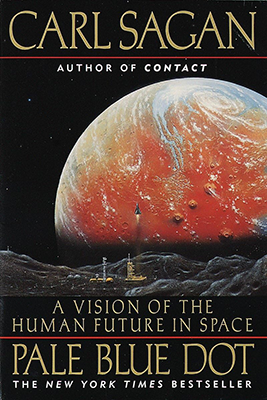Pale Blue Dot
“Pale Blue Dot: A Vision of the Human Future in Space” is a book by Carl Sagan, published in 1994. Here’s a summary:
Introduction: Carl Sagan introduces the concept of the “pale blue dot,” a photograph of Earth taken by the Voyager 1 spacecraft from a distance of about 6 billion kilometers (3.7 billion miles) away. He reflects on the significance of this image and what it reveals about our place in the cosmos.
The Overview Effect: Sagan discusses the profound impact of seeing Earth from space, known as the “overview effect,” on astronauts and humanity as a whole. He explores how this perspective can inspire a sense of unity, awe, and responsibility toward our planet.
The History of Space Exploration: Sagan traces the history of space exploration, from the early days of human curiosity about the stars to the development of space probes and manned missions to the Moon and beyond. He highlights the achievements and challenges of space exploration and its potential for advancing scientific knowledge and human civilization.
The Search for Extraterrestrial Life: Sagan explores the possibility of life beyond Earth and the scientific efforts to search for extraterrestrial intelligence (SETI). He discusses the conditions necessary for life to exist elsewhere in the universe and the methods used to detect signs of life on other planets.
Environmentalism and Planetary Stewardship: Sagan emphasizes the importance of environmentalism and planetary stewardship in light of the fragile and interconnected nature of Earth’s ecosystems. He discusses the environmental challenges facing humanity, such as climate change and pollution, and advocates for sustainable practices to protect our planet.
The Future of Humanity in Space: Sagan speculates about the future of human exploration and colonization of space. He discusses the potential benefits and risks of space travel, the ethical considerations of terraforming other planets, and the prospects for interstellar travel and communication.
Cosmic Perspectives: Sagan reflects on the vastness and beauty of the cosmos and the humbling realization of humanity’s place within it. He discusses the wonders of the universe, from distant galaxies to the intricacies of particle physics, and the quest for understanding and meaning in the face of cosmic mysteries.
Conclusion: Sagan concludes by urging readers to cherish and preserve the precious “pale blue dot” that is Earth. He emphasizes the importance of scientific curiosity, environmental stewardship, and compassion for all life on our planet as we navigate the challenges and opportunities of the space age.
In summary, “Pale Blue Dot” offers a thought-provoking exploration of humanity’s relationship with the cosmos, encouraging readers to consider the big questions of existence and our responsibility as stewards of Earth’s future.

